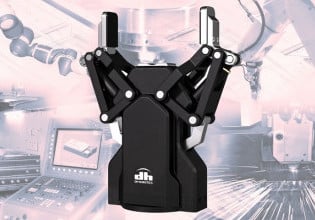New Study on Soft Robotics Takes Inspiration From Octopus Arm Muscles
Scientists from the University of Illinois Urbana-Champaign have developed an octopus-inspired soft robot model that is accurate in design and control.
Researchers at the University of Illinois Urbana-Champaign have created a framework for the design and control of soft robots by developing a physiologically accurate model of octopus arm muscles. The study, published in the Proceedings of Royal Society A journal, gives a comprehensive insight into the complex design and biomechanics of the internal muscles of octopuses.

Model of octopus soft robot grasping the surface of a cylinder. Image used courtesy of the University of Illinois Urbana-Champaign
Soft Robotics Research
Prashant Mehta and Mattia Gazzola are the two professors who led the research at the University of Illinois Urbana-Champaign, department of mechanical science & engineering. The research team also included Heng-Sheng Chang graduate students and Udit Halder, a postdoctoral scholar. The team developed a soft robot model of octopus arm muscles—the first of its kind. The office of Naval Research supported the Coordinated Science Laboratory in developing the soft robot.

Longitudinal, transverse, clockwise oblique, and counterclockwise muscle simulation of muscular arm model. Image used courtesy of the University of Illinois Urbana-Champaign
Bio-inspired Robotics
The study's researchers were inspired by the octopus arm's flexibility and operating system, which three major internal muscle groups control. These three muscle groups collaborate in creating a diverse range of movements, giving the octopus arm degrees of freedom to move and bend in various directions:
- The longitudinal muscle allows the muscle to either extend or retract and run parallel to the long axis of the arm.
- The transverse muscle allows for the expansion and retraction of the arm as they run perpendicular to the longitudinal muscles.
- The oblique muscle controls the twisting and rotation of the octopus arm, either clockwise or counterclockwise.
The researchers mimicked these arm muscles using a stored energy function, a concept from the theory of continuum mechanics. Researcher Udit Halder described the process: "The arm rests at the minimum of an energy landscape. Muscle actuations modify the stored energy function, thus shifting the equilibrium position of the arm and guiding the motion."

The new study aims to expand the capabilities of soft robotics technology in use today. Image used courtesy of Soft Robotics
Octopus-like Robots
The application of soft robotics in various industries is gaining traction. The development of octopus arm muscles that are physiologically accurate to enhance control and the design of soft robots can further boost their potential to infiltrate the robotics market, making an impact in applications such as surgery, agriculture, manufacturing. This may, however, take some time before it reaches the mainstream market because of the need for regulatory approval and more research and development.






